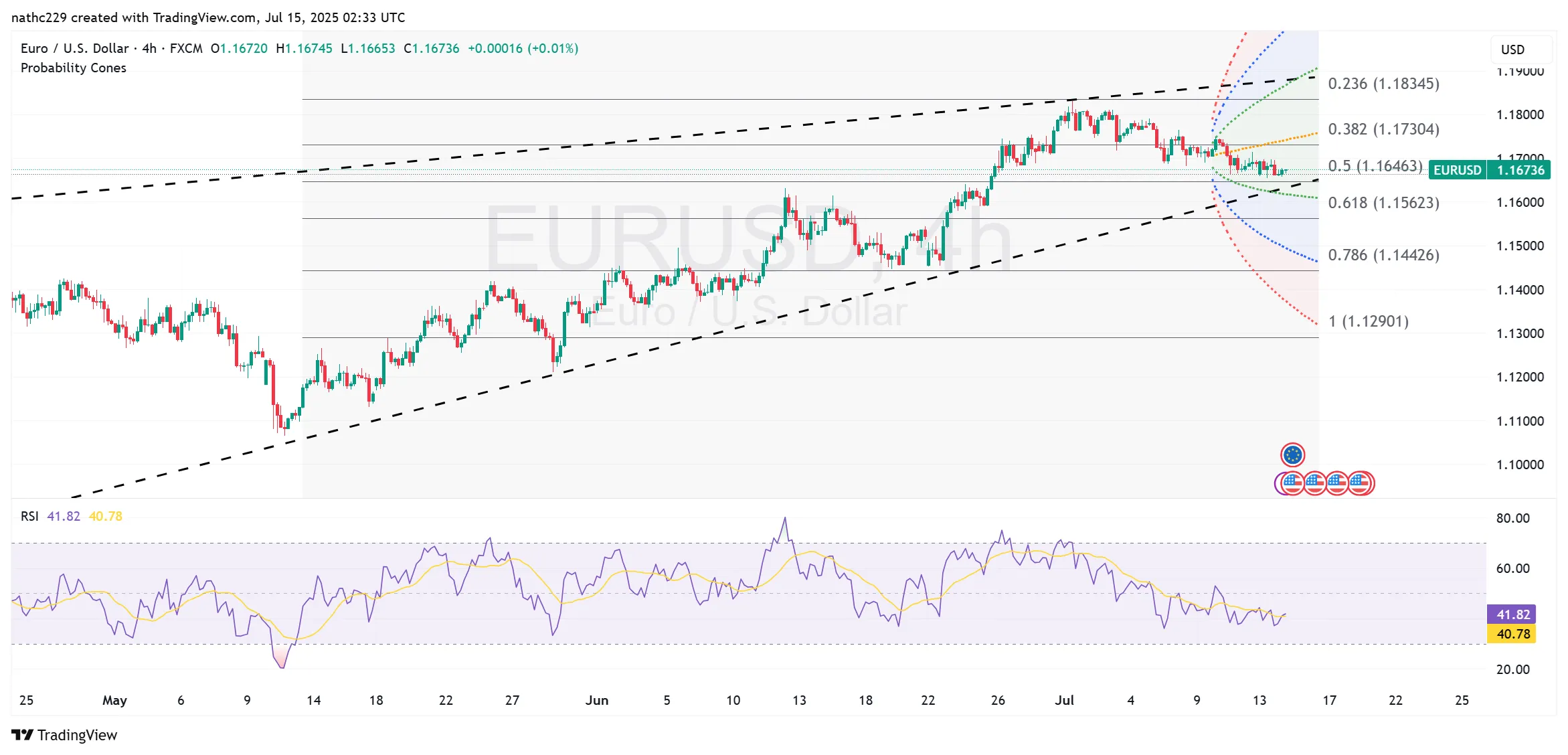
EUR/USD Bears Strengthen Grip as Tariff Threats and Technical Indicators Signal Further Declines
EUR/USD Bears Strengthen Grip as Tariff Threats and Technical Indicators Signal Further Declines
Overview
EUR/USD continues to experience intense downward pressure, underpinned by escalating trade tensions, rising U.S. yields, and weakening technical signals. Recent price action underscores the euro’s vulnerability, particularly as threats of additional U.S. tariffs on European imports loom large. Investors remain wary, closely monitoring economic data releases and central bank signals to gauge further direction.
Technical Analysis
EUR/USD initiated the New York session at the upper bounds of its overnight trading range between 1.1650 and 1.1697, only to encounter significant selling pressure throughout the day. Despite a brief intraday rally attempt towards 1.1695, renewed bearish sentiment quickly reemerged, pushing the pair sharply lower.
The currency pair decisively fell below its critical 21-day moving average, trading down approximately 0.26% and approaching the 1.1660 support level. Immediate technical supports now reside around the recent low near 1.1660, followed closely by significant psychological support at 1.1600.
On the downside, further technical levels to monitor include the lower daily Bollinger Band around 1.1550, and a deeper support zone near 1.1500, aligning with June’s key lows. The prevailing technical indicators, including daily and monthly inverted hammer candlestick formations and steadily declining Relative Strength Index (RSI) readings on both timeframes, strongly reinforce bearish sentiment.
Resistance is clearly defined at recent highs near 1.1697, with the 21-day moving average, now at approximately 1.1700, representing a formidable barrier. Above this, further resistance is situated at the declining 10-day moving average around 1.1725, which continues to suppress bullish recovery attempts.
The technical landscape strongly favors continued bearish momentum, with key technical barriers limiting any potential upside retracements.
Economic Indicators and Market Drivers
Several fundamental factors currently weigh heavily on EUR/USD. President Trump’s recent announcement threatening a 30% tariff on European Union imports has significantly intensified bearish sentiment. This potential tariff implementation, set for August 1, poses substantial risks to the Eurozone economy by potentially reducing exports and economic growth in a region heavily dependent on U.S. trade.
Simultaneously, rising U.S. inflation expectations contribute to sustained dollar strength, diminishing prospects for near-term Federal Reserve rate cuts. Recent upward trends in U.S. 2-year and 5-year breakeven inflation rates underscore market perceptions of persistent inflationary pressures, which bolster the dollar’s appeal relative to the euro.
Upcoming U.S. economic data, particularly the Consumer Price Index (CPI) and Producer Price Index (PPI) for June, remain critical. Stronger-than-anticipated inflation readings would likely solidify market expectations for a less accommodative Fed, supporting further dollar strength and exacerbating EUR/USD downside pressures.
Meanwhile, the European Central Bank (ECB) faces renewed pressure to reassess its monetary policy stance amid weaker economic prospects driven by potential trade disruptions. The threat of tariffs combined with recent euro strength could lead the ECB to consider additional easing measures, further undermining euro support.
Risks and Potential Consequences
EUR/USD faces multiple near-term risks that could further exacerbate bearish sentiment. Primary among these is the imminent tariff threat, which could severely impact European economic performance if implemented. Continued deterioration in EU-U.S. trade relations would significantly weaken investor confidence, negatively impacting the euro.
Moreover, persistent U.S. inflationary pressures and robust economic data could further reinforce market expectations of delayed Fed rate cuts, providing continued upward support for U.S. yields and the dollar.
From a technical perspective, sustained bearish momentum below current key support levels around 1.1660 would significantly increase the probability of deeper declines, targeting lower technical supports near 1.1500 and potentially the critical 1.1350-1.1400 area.
Trading Recommendations
Bearish traders currently hold a strong advantage, with clear bearish momentum and significant technical resistance above. Traders should consider maintaining or expanding short positions, strategically placing stop-losses slightly above the critical 21-day moving average (1.1700) and the declining 10-day moving average (1.1725).
Bullish traders must exercise extreme caution, awaiting clear signals of technical stabilization or potential reversal patterns before considering new long positions. Stronger-than-expected economic data from Europe or a positive resolution of trade tensions would be essential to reverse current bearish sentiment.
Conclusion
EUR/USD faces significant bearish pressures driven by heightened trade tensions, strong U.S. inflation expectations, and deteriorating technical indicators. Traders should remain vigilant, closely monitoring upcoming economic data and geopolitical developments to effectively navigate potential volatility and identify strategic trading opportunities.
